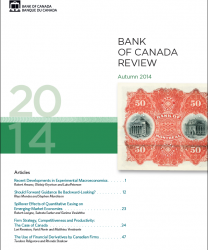Bank of Canada Review - Autumn 2014
In this issue, Bank staff discuss recent developments in experimental macroeconomics, research results on price-level and unemployment thresholds in forward guidance, and the spillover effects of quantitative easing in advance economies. Articles also explore the competitiveness strategies of Canadian firms as well as their use of financial derivatives.
The Bank of Canada Review is published twice a year. Articles undergo a thorough review process. The views expressed in the articles are those of the authors and do not necessarily reflect the views of the Bank.
The contents of the Review may be reproduced or quoted, provided that the authors and the publication, with its date, are specifically cited as the source.
